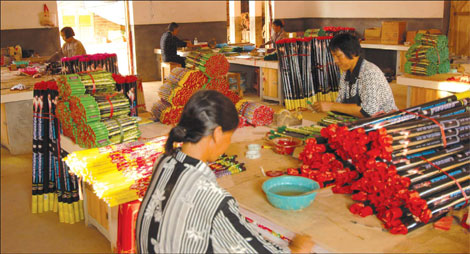Companies
Mechanization holds key to future
Updated: 2011-07-01 13:29
By Liu Xiaozhuo (China Daily European Weekly)

Fireworks industry must reorient itself to stay afloat, say experts
It is an industry that has a rich history of more than 2,000 years. But it is also an industry that has been relatively slow in embracing technology and modern methods of manufacturing.
Chinese fireworks producers are now planning to take advantage of the large-scale use of machines in the process of production, but complete mechanization of the industry is still a far cry, say experts. But the first steps have been taken and there has been considerable progress, they say.
Yang Shengjun, chairman of the Executive Committee of International Fireworks Association, says that 50 to 60 percent of the 7,000 fireworks producers under the association are already using machines in the manufacturing process.
According to Qian Xinming, a professor at the Beijing Institute of Technology who specializes in fireworks technology, most of the large and medium-sized fireworks companies in China have started to use machines in the production process.
The Chinese fireworks industry started using machines on a small scale during the 1970s and 1980s. Most of the production is still manual and hazardous as it often involves the use of poisonous chemicals. But mounting safety and environmental concerns are now triggering a shift to more modern and controlled manufacturing processes.
Zhong Ziqi, managing director of Dongxin Fireworks, one of China's biggest fireworks producers, says that by using machines in the manufacturing process, the safety of workers can be guaranteed to a large extent. The machines can mix the explosive powder safely, while the whole process can be monitored through display screens to ensure that the mix and the product are in accordance with the set standards, he says.
Lidu Fireworks Corporation Ltd based in Jiangxi province is the largest fireworks exporter in China, with an annual production of around 360,000 tons. The company exports most of its products to markets in America and Europe and has been at the forefront of industry mechanization.
Zhang Xiaocheng, lead production engineer at Lidu Fireworks says his company started to use machines in the 1980s. The company not only incorporated machines, but also undertook research on fireworks machines technology.
Zhang says that there are more than 200 fireworks machines in Lidu now valued at more than 10 million yuan. "By using machines we can separate people from the explosive powder, and it increases production safety," he says.
According to data from the Beijing Institute of Technology, the qualification-passing rate of Chinese fireworks has improved considerably after the use of machines in the manufacturing process. The passing rate in 2009 was 60.8 percent, while it improved to 70.5 percent in 2010.
Unlike manual operations, the machines also help improve the overall efficiency. "The working speed of machines is five to six times faster than humans," Zhang says.
The high accident rate has often been a deterrent for attracting fresh labor to the industry. To address these issues, while it is essential to retain existing talent with better pay, there is also the need to reduce the danger to life by using more and more machines.
Zhao Jiayu, an expert from Fireworks Standardization Commission of China, says that there are around 3 million people working in the fireworks industry. "In 2020 the percentage of enterprises using machines for manufacture will increase to 90 percent," Zhao says.
According to Zhang, Lidu Fireworks plans to expand its machinery production and will buy more machines in the future.
Though there are many advantages, machines cannot account for the entire production process, Qian says. "They can only account for a few steps in the cycle."
Regular fireworks production process includes 10 to 20 procedures and some fireworks need more complicated manufacturing skills, he says.
Zhang, who introduced some creative fireworks, like the "smiling face" fireworks during the opening ceremony of the 2008 Olympic Games agrees.
"Some fireworks require special patterns and colors. In such cases, machinery output cannot replace handwork. Fireworks are not just an industrial product, or a process that uses technology. Firework is also an art," Qian says.
Such an argument makes sense as there are several thousands types of fireworks in China, each of which needs a different manufacturing process. Against such a backdrop, the goal of complete mechanization seems difficult to achieve unless the industry goes for a standardization of products.
Qin says that smaller manufacturers are reluctant to buy machines considering the huge investments they have to make in the face of meager returns from fireworks sales.
The absence of nationwide fireworks machinery makers is another limiting factor. Many of the equipment makers are centered in Liuyang, Hunan province, as most of the fireworks companies are based there, Zhang says.
Li Changsheng, owner of a Liuyang-based fireworks machine factory, says that there are more than 500 to 600 factories in Liuyang alone. "Although there are many factories making fireworks machines, most of them are run by individuals and have not ventured into large-scale production," he says.
Li says that his company produces 1,000 to 2,000 fireworks machines every year valued between 4 million (437,084 euros) to 5 million yuan.
Yet another challenge faced by many machine makers is that they do not have the requisite personnel to provide after-sales and technical support. They also do not have enough professionals to conduct advanced research for new machine development.
Zhong feels that the government should provide a program to improve the development of fireworks machines. "The products of many fireworks machines makers are not of good quality. It is really necessary to standardize this industry," he says.
The Liuyang government has already started to look at consolidation and commenced measures to integrate small-sized private machine makers into enterprises capable of large-scale production.
Yang says that 90 percent of the fireworks products in the world are made in China. The US is the largest market for Chinese fireworks products export. In 2010, exports to the US was valued at nearly $175 million, while those to Europe were around $227 million.
"Lower price and safety are the main requirements in foreign markets and also the main challenges for Chinese fireworks companies. We must develop machinery that will address these issues," Yang says.

Specials

90th anniversary of the CPC
The Party has been leading the country and people to prosperity.

Premier Wen's European Visit
Premier Wen visits Hungary, Britain and Germany June 24-28.

My China story
Foreign readers are invited to share your China stories.